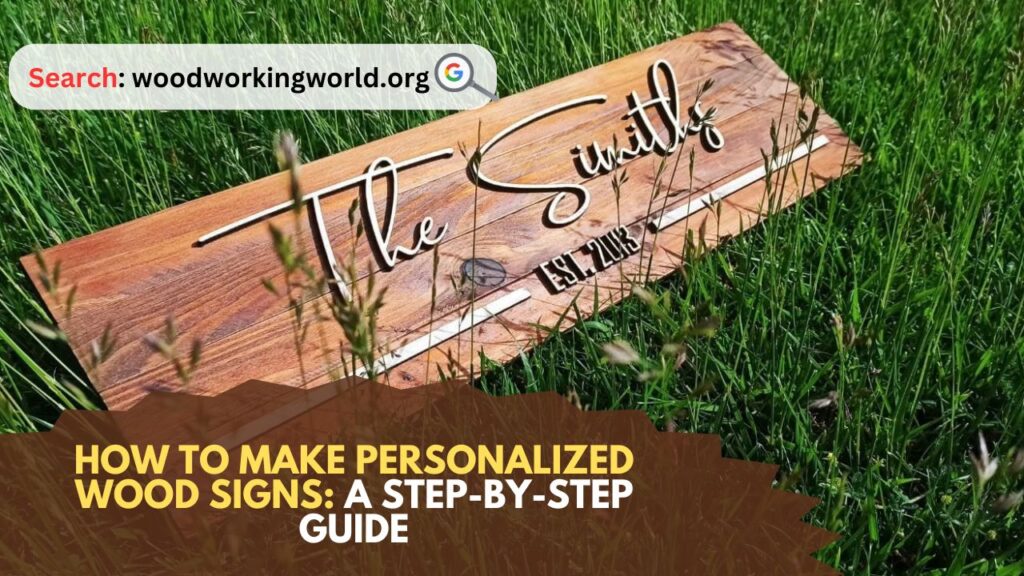Personalized Wood Signs: Creating personalized wood signs is a rewarding and creative endeavor that can add a unique touch to your home, make thoughtful gifts, or even serve as a profitable business venture. Whether you’re a seasoned woodworker or a beginner, this guide will walk you through the process of making your own personalized wood signs from start to finish.

How to Make Personalized Wood Signs
Materials and Tools You Will Need
Before you begin, gather all the necessary materials and tools. Here’s a list of what you’ll need:
Materials:
- Wooden board (type of wood depends on your preference)
- Sandpaper (various grits)
- Wood stain or paint
- Sealant (polyurethane or similar)
- Transfer paper or stencil
- Acrylic paint or paint markers
- Painter’s tape
Tools:
- Measuring tape
- Pencil
- Ruler or straight edge
- Saw (if cutting your own wood)
- Paintbrushes or foam brushes
- Drill (optional, for hanging)
- Sander (optional, for larger projects)
- Computer and printer (for designing and printing text/images)
Step 1: Choosing the Wood
The first step in making a personalized wood sign is choosing the right wood. The type of wood you select can affect the overall look and feel of your sign. Here are some common types of wood used for signs:
- Pine: Softwood that is easy to work with and readily available. It has a smooth grain that’s ideal for painting.
- Cedar: Known for its natural resistance to decay and insects. It has a beautiful grain pattern and is great for outdoor signs.
- Oak: Hardwood with a prominent grain that looks beautiful when stained. It’s durable but can be harder to work with.
- Plywood: An economical choice that is easy to cut and paint, although it doesn’t have the natural beauty of solid wood.
Step 2: Preparing the Wood
Once you’ve chosen your wood, it’s time to prepare it for painting or staining. Follow these steps:
- Cut the Wood: If you haven’t purchased a pre-cut board, measure and cut your wood to the desired size using a saw. Be sure to wear safety goggles and follow proper safety protocols.
- Sand the Surface: Use sandpaper or a sander to smooth out the surface of the wood. Start with a lower grit (e.g., 80) and work your way up to a higher grit (e.g., 220) for a smooth finish. Sand the edges as well to remove any rough spots.
- Clean the Wood: Wipe down the wood with a damp cloth to remove any dust from sanding. Let it dry completely before moving on to the next step.
Step 3: Staining or Painting the Wood
Now that your wood is prepared, it’s time to add some color. You can either stain the wood to highlight its natural beauty or paint it for a more vibrant look.
Staining:
- Apply Stain: Using a brush or cloth, apply the wood stain evenly across the surface. Follow the manufacturer’s instructions for drying times and additional coats.
- Wipe Off Excess: After applying the stain, use a clean cloth to wipe off any excess. This will help ensure an even finish.
- Let It Dry: Allow the stain to dry completely before proceeding. This can take several hours to overnight, depending on the type of stain and humidity levels.
Painting:
- Apply Primer: If you’re using paint, start by applying a primer to help the paint adhere better and provide a smooth base.
- Paint the Wood: Once the primer is dry, apply your chosen paint using a brush or foam roller. You may need multiple coats for full coverage. Let each coat dry before applying the next.
- Let It Dry: Allow the paint to dry completely before adding any text or images.
Step 4: Designing Your Sign
The next step is to decide what you want your sign to say and how you want it to look. Here are a few tips for designing your sign:
- Choose Your Text: Decide on the text you want to include. This could be a family name, a favorite quote, or a special date.
- Select a Font: Choose a font that matches the style of your sign. Serif fonts tend to look more traditional, while sans-serif fonts are more modern. Script fonts can add a touch of elegance.
- Plan Your Layout: Use a computer program like Microsoft Word, Photoshop, or a free online design tool to lay out your text and any images or decorative elements. Print out your design to use as a guide.
Step 5: Transferring the Design to the Wood
Once you have your design ready, you need to transfer it to the wood. There are several methods you can use:
Using Transfer Paper:
- Print Your Design: Print your design onto regular paper.
- Position the Transfer Paper: Place the transfer paper face down on the wood, and then place your printed design on top of it.
- Trace the Design: Use a pencil or pen to trace over the design, pressing firmly. The transfer paper will leave an outline on the wood.
Using a Stencil:
- Create or Purchase a Stencil: You can create your own stencil using a cutting machine like a Cricut or purchase pre-made stencils.
- Position the Stencil: Secure the stencil on the wood using painter’s tape.
- Apply Paint: Use a brush or sponge to apply paint over the stencil. Be careful to apply it evenly and avoid bleed-through.
Step 6: Painting the Design
With your design transferred to the wood, it’s time to paint it. Here’s how:
- Choose Your Paint: Use acrylic paint or paint markers for detailed work. These are available in a variety of colors and finishes.
- Paint the Design: Carefully paint over the transferred design. Use small brushes for intricate details and larger brushes for bigger areas. Take your time to ensure clean lines and even coverage.
- Let It Dry: Allow the paint to dry completely. This may take several hours, depending on the thickness of the paint.
Step 7: Sealing the Sign
To protect your sign and ensure it lasts, apply a sealant. This is especially important for outdoor signs.
- Choose a Sealant: Use a clear polyurethane or a similar sealant suitable for wood.
- Apply the Sealant: Using a clean brush, apply a thin, even coat of sealant over the entire sign. Follow the manufacturer’s instructions for drying times and additional coats.
- Let It Dry: Allow the sealant to dry completely. This can take several hours to overnight, depending on the type of sealant and humidity levels.
Step 8: Adding Hanging Hardware (Optional)
If you plan to hang your sign, you’ll need to add some hardware.
- Drill Holes: If you want to use screws or nails to hang the sign, drill small holes in the back of the sign.
- Attach Hanging Hardware: You can use D-rings, sawtooth hangers, or picture wire, depending on your preference. Secure the hardware to the back of the sign using screws.
- Hang the Sign: Use appropriate wall anchors or hooks to hang your sign securely.
Conclusion: Personalized Wood Signs
- Experiment with Styles: Don’t be afraid to experiment with different styles, colors, and finishes. Personalized wood signs can be rustic, modern, vintage, or anything in between.
- Practice Makes Perfect: If you’re new to sign-making, practice on scrap pieces of wood before working on your final piece.
- Gift Ideas: Personalized wood signs make excellent gifts for weddings, anniversaries, birthdays, and holidays. Consider adding special touches like family crests, monograms, or meaningful quotes.
- Selling Your Signs: If you’re interested in selling your signs, consider setting up an online store on platforms like Etsy or promoting your work on social media.
By following these steps and using your creativity, you can create beautiful personalized wood signs that are perfect for any occasion. Whether you’re making them for yourself or as gifts, these signs are sure to be cherished for years to come. Happy crafting!
I hope this article on Personalized Wood Signs has been helpful. If you have any further questions, please feel free to leave a comment below.
Video
